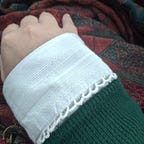The Argument For Wool
As trends toward animal-free products gain popularity, it’s clear that there must be one exception: wool.
I remember the first time I saw Peta’s anti-wool campaign. Images of bloody and battered lambs as the apparent result of the violence of sheep-shearing were shocking to me. Not because they opened my eyes to the evils of wool, but because I grew up in an agricultural community and had family members who raised sheep. I was shocked that so many people believed this to be true when I knew the reality to be different.
These ad campaigns may be very effective for people who live in urban environments because they are far removed from the reality of agriculture. Indeed, I have found strict veganism to be far less popular in communities where local agriculture is still practiced. And that’s for good reason. If you can get eggs from neighbors whose chickens you see roaming around feasting on lawn bugs, you know they are being raised as nature intended.
It’s industrial agriculture that has encouraged people to eat far too much meat and dairy. And it’s focus on animals as products to be churned out as quickly and cheaply as possible has caused inhumane treatment to run rampant. Wool farming, however, still exists in many places in more traditional forms.
Sheep have been domesticated since the dawn of civilization and bred to have fine…
